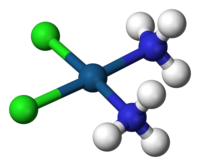
Photo from wikipedia
Abstract Entropy stabilised materials have possibilities for tailoring functionalities to overcome challenges in materials science. The concept of configurational entropy can also be applied to metal oxides, but it is… Click to show full abstract
Abstract Entropy stabilised materials have possibilities for tailoring functionalities to overcome challenges in materials science. The concept of configurational entropy can also be applied to metal oxides, but it is unclear whether these could be considered as solid solutions in the case of perovskite-structured oxides and if the configurational entropy plays a stabilising role. In this study, compositionally complex perovskite oxides, LnMO3 (Ln = La, Nd, Sm, Ca and Sr, M = Ti, Cr, Mn, Fe, Co, Ni, and Cu), are investigated for their phase stability and magnetic behaviour. Phase-pure samples were synthesised, and the room temperature structures were found to crystallise in either Pnma or R 3 ¯ c space groups, depending on the composition and the resulting tolerance factor, while the structural transition temperatures correlate with the pseudo cubic unit cell volume. The techniques used included diffraction with X-rays and neutrons, both ex- and in-situ, X-ray photoelectron spectroscopy, magnetometry as well as electron microscopy. Neutron diffraction studies on one sample reveal that no oxygen vacancies are found in the structure and that the magnetic properties are ferrimagnetic-like with magnetic moments mainly coupled antiferromagnetically along the crystallographic c-direction. X-ray photoelectron spectroscopy gave indications of the oxidation states of the constituting ions where several mixed oxidation states are observed in these valence-compensated perovskites.
Journal Title: Journal of Solid State Chemistry
Year Published: 2021
Link to full text (if available)
Share on Social Media: Sign Up to like & get
recommendations!